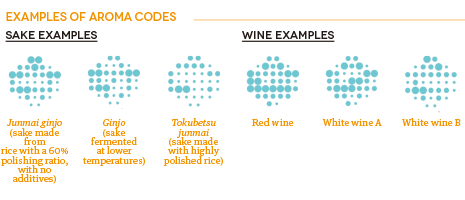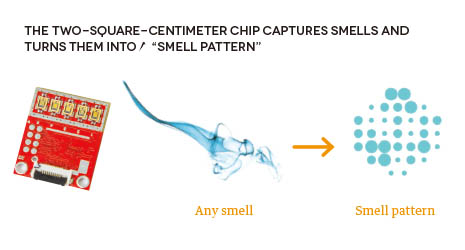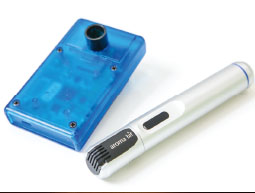Home > Highlighting JAPAN > Highlighting Japan April 2019 > Science & Technology
Highlighting JAPAN


Portrait of a Scent
Of our five basic senses, the hardest to digitize is our sense of smell. Now there’s a technology that can detect scents with a high degree of sensitivity and create a visual representation of them. One day it may be possible to select a wine, make jobsites safer and more by simply checking an image depicting their olfactory profile.
When we eat or drink something and it tastes delicious, we don’t just sense it with our tongues. Our perception of taste is also influenced by scent. However, aromas are difficult to pin down, and how something smells and how to describe the aroma varies from person to person. While these factors make digitizing smells tough, a Japanese startup company called Aroma Bit, Inc. has succeeded at creating a way to “see” scent.
“Of our five primary senses—sight, hearing, touch, smell, and taste—sight and hearing were the first to be digitized. The process of digitizing touch and taste is also becoming a reality, leaving the sense of smell last in line. I thought that if we could digitize smell, we could contribute to the world in an entirely new way,” explains CEO Shunichiro Kuroki of Aroma Bit as he describes what led to devising an aroma sensor.
Using gas sensors to detect aromas is an established method, but these sensors work completely differently from the human nose. For instance, while a gas sensor picks up a scent and judges it to be “approximately ten percent ammonia,” humans are more intuitive, describing the same scent as “smelling kind of sharp.” Kuroki wanted to create a sensor that was closer to how humans judge odors.
Instead of a device that measures the composition and substances of a smell, he developed an “odor receptor membrane” modeled on the olfactory receptors of living creatures. It captures the chemical changes that occur when scent particles stick to and separate from this membrane, and recognizes them as scent patterns.
Aroma Bit’s aroma sensor is a small, two-square-centimeter chip loaded with five types of odor receptor membranes. When you place their proprietary device that analyzes the chip near the origin of a smell, the fan starts to spin, taking in air and detecting the scent.
Humans are said to have roughly four hundred types of olfactory receptors. Aroma Bit has currently developed thirty-five types of scent elements, with a sensitivity close to that of humans. Aroma Bit’s method for visualizing captured scents is also original.
The scents the sensor captures are assigned numerical values, then given labels—“aroma codes” that represent the smell by dot size. If two label patterns are similar, it means the scents are similar as well, making scent something that can be visualized. Even if people can’t actually smell a product in person—such as when purchasing online—they can look at the label and choose their preferred fragrance. Companies that make wine, cheese, sake and coffee are already introducing aroma codes for their products.
Aside from luxury food and drink, the aroma sensor is also being considered as a method for analyzing industrial oil odors in factories. For example, an odor sensor could catalogue all the common, day-to-day odors from a jobsite. If the system detects an odor out of the ordinary, the sensor could send out an alert. Unlike a gas sensor designed to detect only gas changes, the system could react to potential and unforeseen dangers. The odor sensor could also help in verifying the safety and shelf life of products, since it can detect the slightly sour smell of milk just as the product is starting to turn.
“Even when we’re just breathing, we are unconsciously influenced by our sense of smell, and it’s said that smell has a big role in compatibility with romantic partners,” says Kuroki, with high hopes for the possibilities of scent sensors. “And if we can create an even more advanced sensor, it could take in the survival scents given off by plants and insects, and we could decode nature’s messages.”
© 2009 Cabinet Office, Government of Japan








